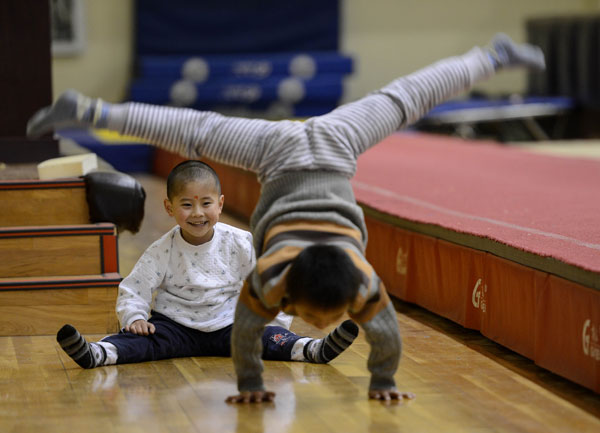Children deserve a sporting chance
Updated: 2013-03-13 07:19
By Tang Zhe and Hu Haiyan (China Daily)
|
||||||||
Ensuring physical fitness for the young must be a priority, report Tang Zhe and Hu Haiyan in Beijing.
In recent years, China has demonstrated its position as one of the world's most competitive sporting powerhouses. The improvement has been signaled through success at the Olympic Games, highlighted by China's highest gold medal tally of 51 at Beijing 2008 and 38 at London 2012. However, in contrast with the nation's prowess in athletics, the overall fitness of the general public, and children in particular, has become a cause for concern.
The problem is twofold: Most of the participants of a nationwide program to promote fitness are retirees with no academic or work pressures to contend with; and the emphasis on academic excellence, coupled with the rigors of the gaokao, the nation's university entrance exam, mean that it's not unusual for schools to replace physical education classes with extra tuition or examinations.
The issue, which has attracted wide public attention, has been a hot topic at the annual sessions of national legislative and political advisory bodies.
Members of the Chinese People's Political Consultative Conference National Committee, the country's top advisory body, have suggested a range of measures.
One suggestion is that physical education should be listed as a part of the gaokao, an initiative that could be backed by policies and regulations to ensure the quality of sporting education.
The physical condition of university students has been declining for some time, according to an investigation by the Ministry of Education and General Administration of Sport in 2010, which covered 31 provinces and regions and 995 schools. The probe found that the cardiopulmonary functions of undergraduates had fallen by 10 percent since 1985, according to People's Daily.
Meanwhile, although the overall level of fitness of elementary- and middle-school students has shown signs of improvement after a 25-year decline, conditions such as obesity and myopia continue to increase within the target groups. Forty percent of elementary school students are myopic, a rise of 9 percent from 2005, while more than 80 percent of college students have the condition, which many observers attribute to overzealous attention to schoolwork and computer screens.
 |
|
Children fi nd an outlet for their energy at a school in Shanghai. AN LINGJUN / FOR CHINA DAILY |
- Five children drowned in Shanxi reservoir
- 63 trafficked children rescued in China
- Shanghai auction raises funds for underprivileged children
- 11 school children killed in road mishap in India
- Families with missing children need support
- Deaths of 7 orphanage children confirmed
- Young delegate takes up migrant children cause
- Children deaths lead to calls for better guardianship
- Runaway Benxi children return home safely
- 3,000-plus Chinese children adopted overseas

 Li Na on Time cover, makes influential 100 list
Li Na on Time cover, makes influential 100 list
 FBI releases photos of 2 Boston bombings suspects
FBI releases photos of 2 Boston bombings suspects
 World's wackiest hairstyles
World's wackiest hairstyles
 Sandstorms strike Northwest China
Sandstorms strike Northwest China
 Never-seen photos of Madonna on display
Never-seen photos of Madonna on display
 H7N9 outbreak linked to waterfowl migration
H7N9 outbreak linked to waterfowl migration
 Dozens feared dead in Texas plant blast
Dozens feared dead in Texas plant blast
 Venezuelan court rules out manual votes counting
Venezuelan court rules out manual votes counting
Most Viewed
Editor's Picks

|

|

|

|

|

|
Today's Top News
Boston bombing suspect reported cornered on boat
7.0-magnitude quake hits Sichuan
Cross-talk artist helps to spread the word
'Green' awareness levels drop in Beijing
Palace Museum spruces up
First couple on Time's list of most influential
H7N9 flu transmission studied
Trading channels 'need to broaden'
US Weekly

|

|








